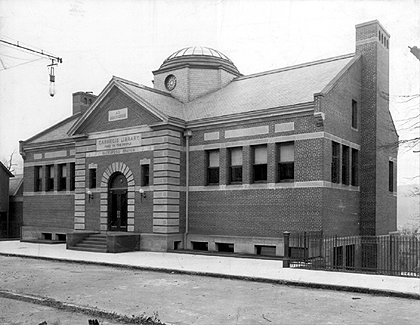

"Pittsburgh Day by Day" by Kenneth Speer in Pittsburgh Sun-Telegraph 13 August 1950.
Fifty years have gone by since the opening of one of
Andrew Carnegie's
branch libraries in one of Pittsburgh's industrial sections--Hazelwood.
And what a difference the years have made.
In the beginning, Hazelwood was a large residential district. It would
seem to have been impossible, but then there were a dozen beautiful
estates along the Monongahela River.
Pittsburgh visitors were taken on tours of the river, past these houses
and estates, for they were the real showplaces of some of Pittsburgh's
luxury living.
And in the back yards of these stately mansions were gardens, for the
loose sandy soil was good for the growing of vegetables, flowers and
fruit trees.
The name of Hazelwood was acquired in this way.
In the district were numerous large hazel trees.
Then one of the first families of the district was named Woods. They had
settled there early in Pittsburgh's history. The families' names were
combined.
Mrs. Woods had a large piano. Some historical data
indicates that her
piano was the first one to be brought across the mountains to Pittsburgh.
It was in the Woods home that Stephen Collins Foster composed some of his music, playing it through on this Woods piano.
Some of the other early families in this Hazelwood district, where a
superhighway through Pittsburgh is now being completed, were the Olivers,
Nixons, Evanses, Scullys and Burgwins.
And Samuel Harden Church, second president of Carnegie Institute, spent
several years of his life in Hazelwood.
When this Hazelwood library first opened,
transportation was quite
different from the trolley and bus routes of
today. Only a few people had their own horse and buggy.
Best way to reach downtown Pittsburgh then was by boat. But the fare was
50 cents--so a great many hoofed it.
The present Bigelow St. in Hazelwood was part of the old Philadelphia
Pike in the days of stagecoaches into Pittsburgh while Braddock's Field Plank Road was
completed in 1851.
That was a toll road, with toll gates at various intervals, as on the
Pennsylvania Turnpike of today. In Hazelwood today is a street called
"Gate Lodge Way," a throwback to those days of the the toll plank
highway.
After the plank road came the old Pittsburgh and Connellsville
Railroad, now the B & O, and when it first went through Hazelwood
area, it would make 13 stops between downtown Pittsburgh and Brown's
Bridge, the spot where you now leave Hazelwood and cross the high level
bridge into Homestead.
After the railroad came Jones & Laughlin Steel. With their expansion
and the location of steel mills and railroad yards in Hazelwood, there
came an increase in population.
Many of the new families were from other lands. Principal nationality
group then was Hungarian. Came also the Italians, Slovaks and Irish.
In the Hazelwood library today is still a collection of books in
Hungarian and the difference in 50 years is that they are not so much in
demand today.
This library opened in a building that cost $40,000 with 5000 books in
the opening collection. It is now over 25,000. The wall decorations are
framed photographs and plaster casts of folks and scenes not only from
Pittsburgh but other parts of the world.
The birthday celebration party is from 1 p.m. to 9 p.m. Wednesday.